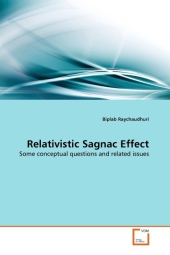 Neuerscheinungen 2010Stand: 2020-01-07 |
Schnellsuche
ISBN/Stichwort/Autor
|
Herderstraße 10
10625 Berlin
Tel.: 030 315 714 16
Fax 030 315 714 14
info@buchspektrum.de |

Biplab Raychaudhuri
Relativistic Sagnac Effect
Some conceptual questions and related issues
2010. 268 S.
Verlag/Jahr: VDM VERLAG DR. MÜLLER 2010
ISBN: 3-639-29679-6 (3639296796)
Neue ISBN: 978-3-639-29679-2 (9783639296792)
Preis und Lieferzeit: Bitte klicken
This book discusses some of the conceptual questions related to the relativistic Sagnac effect in flat and curved spacetimes and some other relevant issues concerning rotating frames. Some paradoxes, namely Ehrenfest, Tippe top and Selleri paradoxes of Special relativity concerning rotating frames are analysed and their resolutions proposed using Sagnac effect as a tool. While the kinematic resolution of the first paradox has been proposed through a unique way using Sagnac effect, another unique approach of using notion of Einstein synchrony in the Galilean world has been adopted to throw light on some subtle issues concerning the later two paradoxes. The treatment of Sagnac effect from the perspective of rotating frame has been discussed to show that for rotating frames in special relativity, Tangherlini transformation representing the absolute synchrony is the preferred one. Finally, Sagnac effect has been discussed in curved spacetimes. In two appendices CS thesis of Special Relativity and different transformations arising from it has been treated pedagogically.
Biplab Raychaudhuri teaches at the Department of Physics, Siksha Bhavana, Visva-Bharati (University), Santiniketan in India. He did his Ph. D. from University of North Bengal. His research interest includes the foundational problems of relativity and different aspects of gravitation and astrophysics.


